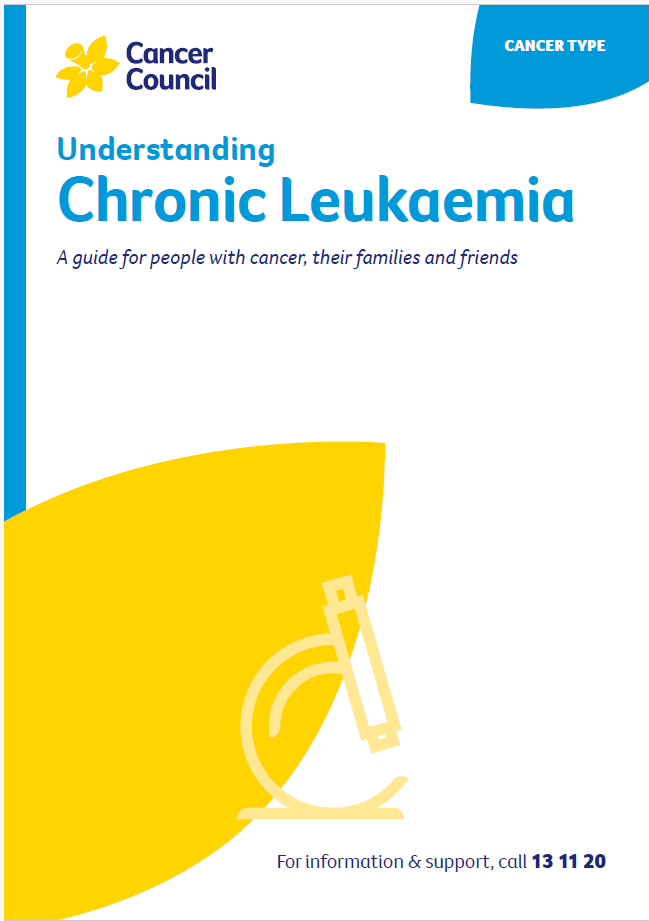Tests for CML
A combination of the following tests will help work out whether you have chronic myeloid leukaemia (CML). You may have a CT scan or ultrasound to confirm the diagnosis.
Learn more about:
Physical examination
Your doctor will examine your body and feel your abdomen to check whether your spleen and liver are enlarged.
Blood tests
A sample of your blood will be sent to a laboratory for a full blood count. This measures the number, size and maturity of each type of blood cell. A specialist doctor called a pathologist will look at the sample under a microscope to check for leukaemia cells.
Learn more about blood tests.
Bone marrow biopsy
A bone marrow biopsy is used to confirm that you have CML and to check how many blood cells are affected. During a bone marrow biopsy, the doctor uses a thin needle to remove a small amount of bone marrow, usually from your hipbone (pelvic bone). You will be given a local anaesthetic to numb the area, or light sedation to help you feel relaxed.
Although it can take up to 30 minutes to prepare for the biopsy, the actual procedure takes only a few minutes. It will be uncomfortable, but you may also be given pain medicine. Pain medicine may make you feel drowsy, so arrange for someone to drive you home afterwards. The bone marrow sample is tested at a laboratory and the results will usually be available within a week.
Genetic tests
Every kind of cancer, including blood cancer, changes the genes of the affected cells. These gene faults are not the same thing as genes passed through families. The fault is only in the leukaemia cells, not in the normal cells.
Doctors use the blood or bone marrow sample to check for gene faults in leukaemia cells. Genetic tests may include:
- FISH (fluorescence in situ hybridisation)
- PCR (polymerase chain reaction).
For CML, the most common gene fault is the presence of the Philadelphia chromosome, which results in the formation of the abnormal BCR-ABL gene. The PCR test is used again during treatment to check how well you are responding, and whether you need a change in treatment.
Philadelphia chromosome
Most cells in the human body have 23 pairs of chromosomes. Chromosomes are threadlike structures that contain sets of instructions known as genes.
In nearly all people with CML, chromosome 22 is abnormal and is known as the Philadelphia chromosome.
The Philadelphia chromosome is not inherited and cannot be passed on to your children – it is a genetic change that happens to some people during their lifetime. This chromosome contains the BCR-ABL gene (see diagram below).
BCR-ABL is considered a cancer gene because it is present only in developing leukaemia cells. It switches on one of the proteins of the leukaemia cells, called tyrosine kinase. This protein tells leukaemia cells to grow and multiply. All people with CML are treated with drugs to block tyrosine kinase (see Targeted therapy).
Gene swap
The Philadelphia chromosome is formed when parts of two chromosomes break off and switch places. A gene from chromosome 22, called BCR, and a gene from chromosome 9, called ABL, create the BCR-ABL gene.

Further tests
Ultrasound
Some people also have an ultrasound to check the size of the spleen and liver. This scan uses soundwaves from a handheld device called a transducer that is moved over your belly area. The soundwaves echo when they meet something solid, such as an organ, and a computer turns the echoes into pictures. Talk to your medical team for more information.
→ READ MORE: Staging for chronic myeloid leukaemia (CML)
Podcast: Tests and Cancer
Listen to more of our podcast for people affected by cancer
More resources
Dr Chun Kei Kris Ma, Clinical Haematologist, Western Sydney Local Health District (clinical update); Delphine Eggen, Consumer; Dr Robin Gasiorowski, Staff Specialist, Haematology, Concord Hospital; Karl A Jobburn, Haematology Clinical Nurse Consultant, Liverpool Hospital; Yvonne King, 13 11 20 Consultant, Cancer Council NSW; Heather Mackay, Clinical Nurse Consultant, Westmead Hospital; Jennifer Paton, Consumer.
View the Cancer Council NSW editorial policy.

